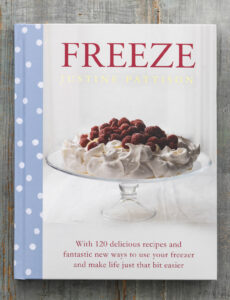 Justine’s book ‘Freeze’ is packed full of information to help you freeze food safely and effectively. Freezing is one of the simplest ways for ensuring that food maintains its quality and texture; it’s also a key technique for making the best use of your food and your budget.
Justine’s book ‘Freeze’ is packed full of information to help you freeze food safely and effectively. Freezing is one of the simplest ways for ensuring that food maintains its quality and texture; it’s also a key technique for making the best use of your food and your budget.
Wrap well:
- To freeze successfully, it’s important to wrap food really well and to freeze it as quickly as possible. Many freezers have a fast-freeze compartment, this helps to prevent ice crystals from forming on food just added to the freezer and protect the quality of food already in the freezer. Other, more advanced freezers have an automatic fast-freeze that cuts in if the temperature of the freezer becomes too warm and then turns off again once food is frozen.
Fast-freeze:
- Set the fast-freeze control or reduce the freezer temperature for 2-5 hours before adding fresh food (check the manufacturers’ guidelines if you can).
- Put well-wrapped and labelled packages in the fast-freeze compartment.
- If you don’t have a special fast-freeze compartment, put food in the coldest part of the freezer and away from already frozen foods.
Add gradually:
Don’t overfill your freezer with fresh food at any one time as your freezer might struggle to maintain the extra low temperature.
If buying in bulk, keep foods in the fridge and add your portions to the freezer one by one when you are sure that the previous portion is frozen. It takes roughly 1-2 hours for a 500g pack of food to preserve. Try not to use more than about 10% of the freezer’s total capacity for freezing fresh food every 24 hours.
As soon as all the fresh food has frozen, turn off the fast-freeze switch or turn up the thermostat so that the freezer can return to its normal setting. This will preserve the quality of the food and save electricity.

